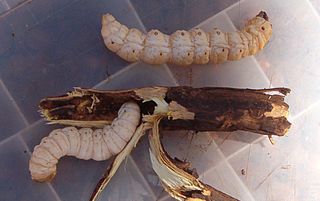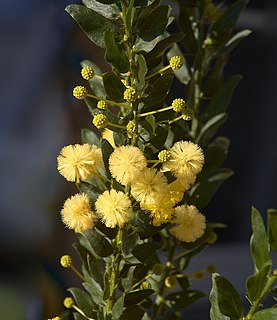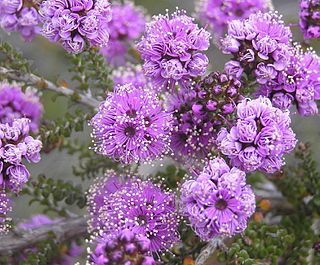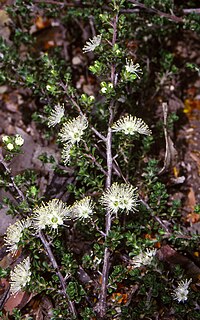
Shittah tree or the plural "shittim" was used in the Tanakh to refer to trees belonging to the genus Vachellia and the genus Faidherbia. Faidherbia albida, Vachellia seyal, Vachellia tortilis, and Vachellia gerrardii can be found growing wild in the Sinai desert and the Jordan valley.

The witchetty grub is a term used in Australia for the large, white, wood-eating larvae of several moths. Particularly it applies to the larvae of the cossid moth Endoxyla leucomochla, which feeds on the roots of the witchetty bush that is found in certain parts of Western Australia, South Australia and widespread throughout Northern Territory.
The term may also apply to larvae of other cossid moths, ghost moths (Hepialidae), and longhorn beetles (Cerambycidae). The term is used mainly when the larvae are being considered as food. The grub is the most important insect food of the desert and has historically been a staple in the diets of Aboriginal Australians.

Acacia kempeana, commonly known as wanderrie wattle, witchetty bush or granite wattle, is a shrub in subfamily Mimosoideae of family Fabaceae. Endemic to Australia, it is widely distributed through arid and semi-arid inland areas of Western Australia, South Australia, the Northern Territory and Queensland.

Kunzea is a genus of plants in the family Myrtaceae and is endemic to Australasia. They are shrubs, sometimes small trees and usually have small, crowded, rather aromatic leaves. The flowers are similar to those of plants in the genus Leptospermum but differ in having stamens that are longer than the petals. Most kunzeas are endemic to Western Australia but are few occur in eastern Australia and a few are found in New Zealand. The taxonomy of the genus is not settled and is complicated by the existence of a number of hybrids.

Kunzea pomifera, commonly known as muntries, emu apples, native cranberries, munthari, muntaberry or monterry, is a low-growing or prostrate shrub with hairy stems, small, mostly egg-shaped leaves, groups of white flowers on the ends of the branches and fleshy, more or less spherical, edible fruit.

Acacia paradoxa is a plant in the Fabaceae family. Its common names include kangaroo acacia, kangaroo thorn, prickly wattle, hedge wattle and paradox acacia.

Kunzea ericifolia, commonly known as spearwood, native tree or yellow kunzea, or as kitja boorn, poorndil or condil by the Noongar people, is an erect woody evergreen shrub that is endemic to Western Australia. It has soft green linear leaves and spherical heads of usually yellow flowers in spring.

Kunzea ambigua, commonly known as white kunzea, poverty bush or tick bush, is a plant in the myrtle family, Myrtaceae and is found mainly on sandstone soils in eastern Australia. Growing up to 5 m (16 ft) high and wide, it bears small white flowers in spring. Used in native gardening, it attracts native insects. It is also used in amenities planting and sand dune stabilization.

Grevillea montis-cole is a shrub which is endemic to central-western Victoria, Australia. It has similarities in appearance to Grevillea microstegia, Grevillea floripendula and Grevillea aquifolium but has larger floral bracts. The flowers, which appear between October and March in its native range, have greenish to fawn perianths and red styles.
Kunzea peduncularis, commonly known as mountain burgan, is a flowering plant in Myrtaceae, the myrtle family, and is endemic to Victoria, Australia. It is usually a dense shrub and has lance-shaped to egg-shaped leaves with the narrower end towards the base. Dense groups of white flowers appear in early summer.
Acacia pyrifolia, commonly known as ranji bush is a shrub that is endemic to the north of Western Australia. It produces rounded yellow flowerheads between April and August in the species native range. It was first formally described in 1825 by Swiss botanist Augustin Pyramus de Candolle in the second volume of his publication Prodromus Systematis Naturalis Regni Vegetabilis.

Acacia cana, or commonly named as boree or the cabbage-tree wattle or broad-leaved nealie, is part of the family Fabaceae and sub-family Mimosoideae. It is a dense shrub- tree that can grow to 6 metres (20 ft) high and is a perennial plant meaning it has long life span and doesn’t necessary produce a high amount of seed. The cabbage-tree wattle heavily flowers from August till October and relies on animals and insects for pollination and dispersal of seeds. This least concern acacia species is found in the western plains of New South Wales and Central Queensland the habitats of these areas are found to be sandy soils and gibber plains.

Kunzea bracteolata is a plant in the myrtle family, Myrtaceae and is found north of Glen Innes in northern New South Wales and in southern Queensland. It is a small shrub with spreading branches, small elliptic leaves and strongly scented white flowers on the ends of the branches in late spring.

Acacia colletioides, commonly known as wait-a-while, pin bush and spine bush, is a shrub of the genus Acacia and the subgenus Plurinerves that is native to Australia.
Kunzea similis is a species of flowering plant in the myrtle family, Myrtaceae and is endemic to a small area along the south coast of Western Australia. It is a shrub with linear to lance-shaped leaves with a single vein, and spherical groups of between four and ten pink flowers on the ends of shoots.

Kunzea pauciflora, commonly known as the Mt Melville kunzea, is a species of flowering plant in the myrtle family, Myrtaceae and is endemic to a small area on the south coast of Western Australia. It is a shrub with the stems densely branched near their ends, linear leaves and one, two or three pink flowers near the ends of the branches but usually only at the top of the shrub.

Kunzea recurva is a flowering plant in the myrtle family, Myrtaceae and is endemic to Western Australia. It is an uncommon shrub with small leaves and groups of pink or purplish flowers on the ends of the branches.

Kunzea badjaensis is a flowering plant in the myrtle family, Myrtaceae and is endemic to a small area of New South Wales. It is a shrub with egg-shaped leaves and clusters of white flowers near the end of the branches. It grows at high altitudes on the Southern Tablelands.

Acacia chisholmii, commonly known as turpentine bush and Chisholm's wattle, is a shrub belonging to the genus Acacia and the subgenus Juliflorae. It is native to arid areas of north eastern Australia.


















